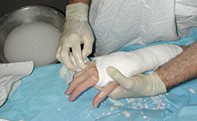Plastering techniques for GP. Part 1: Colles’ fracture cast
Throughout this article, I will describe what I do. However, these are only my personal preferences and do not exclude other preferences, techniques and ‘tricks of the trade’.
Preparation for plastering
Where possible, I prefer to have the patient lying down on a bed or couch (or something similar), with the patient at a comfortable working height so that I do not have to bend forward awkwardly. I arrange as much surrounding working space as possible, using protective covers for the floor, the working area, the patient and the bed. The required materials are placed in a bowl conveniently nearby, adjacent to a bowl of water sufficiently deep to cover a roll of plaster of Paris placed in it – 10 cm is a good depth. I use only cold water, to ensure the greatest possible time until the plaster ‘sets’. This provides more time to mould the cast, ensure an optimal position and ‘work’ the plaster to a smooth finish.

